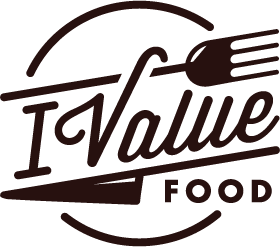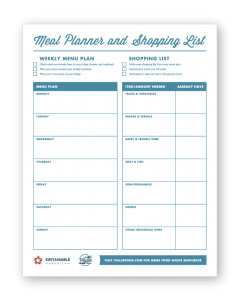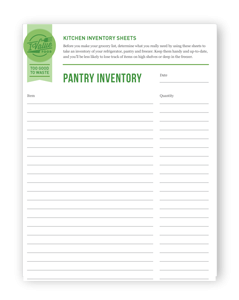Adapted from the EPA’s Food: Too Good To Waste Toolkit
One of the most effective ways to prevent food waste at home is to plan meals ahead of time. That way you’re able to buy only what you need rather than buying “what looks good” at the store and figuring out how to use (or lose) it later.
If you’re the planning type, you may already do this. For the rest of us, planning ahead doesn’t have to be difficult. A pen, paper and a few minutes are all you really need. Here are some tips, plus a simple meal planner you can download and print to help you get started.
1. Plan ahead, but not too far ahead.
Typical menu-planning advice is to plan for a week of meals and shop accordingly, but that doesn’t work for everyone. Here’s another way to think about it: Make a plan based on the meals you will eat at home between now and your next shopping trip. Even if you shop daily, the important part is to have a plan in place before you walk into the grocery store.
2. Shop your fridge and cupboards first.
When planning meals, make a list at what you already have in the fridge, freezer or cupboard that needs to be used up. Is there ground beef hiding in your freezer or a salad’s worth of lettuce that will soon go limp? Incorporate these into your plan and fill in the rest.
One way to keep track of what’s already on hand is to keep a kitchen inventory by making a list of what’s in your refrigerator, pantry and freezer. Keep the lists handy and up-to-date, and you’ll be less likely to lose track of items on high shelves or deep in the freezer. Use our kitchen inventory templates or just a pen and paper.
3. Plan your menu around your weekly activities.
If you have a busy week ahead, are you really going to be able to roast a chicken on Wednesday night? Be realistic about what you can accomplish. Plan quick, easy meals for busy nights, and save the creative menus for nights when you’ll have the time and energy to tackle them.
4. Plan a leftovers night.
Are you likely to have leftovers from any of your meals? Plan an “eat the leftovers” or “smorgasbord” night each week. (Or, store leftovers in lunch-sized portions so they are ready to go the following morning.)
5. Use your menu plan to make a shopping list.
Include quantities on your shopping list to avoid overbuying. For fresh items, note how many meals you’ll make with each. For example: salad greens — enough for two lunches. And — most important — remember to take your list to the grocery store!
6. Place your menu plan on your fridge.
Post your plan where everyone in the family can see it. It will help keep you on track and prevent other family members from picking up extras that aren’t in the plan.
Download the meal planner chart here
Download the kitchen inventory here


















